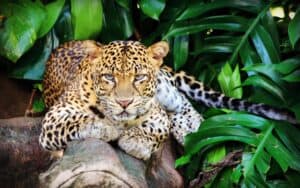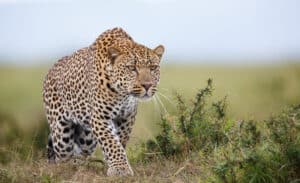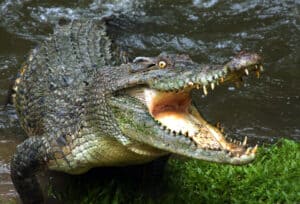Leopards (Panthera pardus) are not social big cats in the same way as lions. They live a mainly solitary life as adults and do not spend a lot of time with other leopards. The exceptions are contact between males and females during the mating season and contact between mothers and their cubs. However, don’t make the mistake of thinking that leopards do not communicate. That is far from the truth! Let’s take a close look at how these amazing animals communicate and then focus on the six sounds leopards make and what they mean.
How Do Leopards Communicate?
Leopards are hunters and search for food over a defined area called their home range. The exact size of the range depends on the region, the density of prey, and how many competitors there are. Males tend to have larger territories than females and they can be as large as hundreds of square miles.
These hunters have very clear ways of telling other leopards where they live. This is largely done through scent marking by spraying urine or anal sac secretions. They also leave visual messages in the form of scratch marks on trees. These visual and chemical markers let other leopards know that a particular range is already occupied. That said, some leopards will tolerate overlapping their range with another leopard but that is most often seen in females.
Do Leopards Communicate With Sound?
Leopards also use sound to communicate, and this is called vocalization. Leopards can be loud! The noises they make can travel for up to two miles. These guys have a more extensive repertoire than you may have guessed, and each sound has a very different meaning. So, here is a quick lesson on how to speak leopard!
1. The Saw
The ‘saw’ was probably given its name because it has the rhythmic sound of a saw being dragged through wood. Some people, however, call it coughing or even rasping. It is a deep and textured sound and is the most distinctive of all the leopard calls. Experts can even identify individual leopards by their sawing call! Thanks to the nature of this sound, it can travel long distances and is probably used to tell other leopards that a particular territory belongs to them. It may also be used to advertise to members of the opposite sex that a leopard is ready to mate.
2. The Roar
Roaring is a very common vocalization among big cats. We have all heard the mighty lion roar but it is also used by tigers and jaguars. Scientists think that some big cats can make this sound because they have an incompletely ossified bone in their throat. The purpose of the roar is not clear; it may be a defensive noise to defend their territory. It is more of a continual, single sound than the saw.
3. The Chuff and Puff
Leopards are able to push air through their nose and lips to make a gentle, rushing sound. This is not designed to travel long distances and is used for close encounters only. It may mean appeasement – to pacify a potential enemy and say ‘can we be friends’. It may also be used during courtship as the male and female get to know each other a bit before mating takes place.
4. The Spit and Hiss
In the same way as domestic cats, leopards can spit and hiss. It’s just more impressive when carried out by such a big cat. They lift up their lips to expose their teeth and expel air through their mouth. It is a much higher-pitched noise than a growl and does not travel a great distance.
Leopards hiss at animals that they don’t like. So, it’s quite common to see them using it during encounters with hyenas! Especially when these pesky scavengers are trying to steal their kills. Hisses can be combined with low growls and snarls to make it quite clear that the leopard is not at all happy! Sometimes, leopards even spit when hissing.
5. The Purr
On the whole, animals that can roar cannot purr. So, lions, tigers, and leopards can roar but not purr. In contrast, bobcats, ocelots, and domestic cats can purr, but they can’t roar. That, however, is not the complete picture.
Leopards can make a sort of purr. It’s a lengthy low sound that is delivered only when breathing out. Cats, on the other hand, can purr when breathing both in and out. Leopards purr for the same reason as our pet cats – they do it as a sign of contentment. You won’t catch an unhappy leopard purring!
6. The Meow
Yes, leopards can meow! But they can only do it when they are young. It’s a high-pitched squealing sound that is designed to get their mother’s attention. It normally means “Mom, I’m hungry,” but cubs may also use it if they are lost or frightened.
Summary of Leopard Sounds
| Sound | Purpose |
|---|---|
| The Saw | To communicate with leopards far away – can be territorial or to find a mate. |
| The Roar | Probably warning and defensive. |
| The Chuff and Puff | Appeasement – can be used before mating. |
| The Spit and Hiss | Defensive – use often to warn off competitors. |
| The Purr | Indicates pleasure. |
| The Meow | Used by young leopards to attract mother’s attention. |
The photo featured at the top of this post is © Anup Shah/DigitalVision via Getty Images
Thank you for reading! Have some feedback for us? Contact the AZ Animals editorial team.






